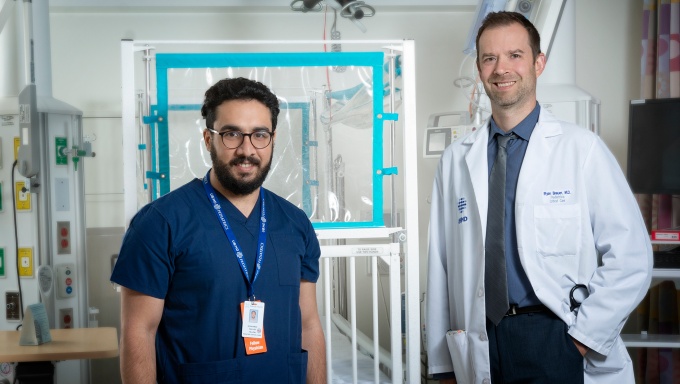Choosing a Pediatric Critical Care Fellowship Program

Fellow Mohammad Sallam, MD, (left) with program director Ryan Breuer, MD.
If you are looking for a fellowship that provides you with the support, opportunities and resources you need to develop as an exceptional pediatric intensivist, we recommend looking for a program with the following five specific attributes:
Top Characteristics of Superior Fellowships
Quality of mentorship
Supportive mentorship is a key element of a strong fellowship. Your mentors should be nationally renowned and engaged in patient care, scholarly activity and teaching. Select a fellowship with a low fellow-to-faculty ratio. Although being accepted to smaller programs is often difficult and competitive, enrolling in a program that has fewer fellows can mean you’ll receive more personal attention from attending physicians.
Breadth of rotations
Effective programs provide in-depth rotations that strengthen your expertise in treating critically ill and surgical patients and collaborating with various subspecialties to deliver expert care over a range of diagnoses and overseeing a multidisciplinary intensive care unit team grounded in humanism and evidence-based practice.
Diverse training environment
Oishei Children’s Hospital is a Level 1 Pediatric Trauma Center and features state-of-the-art technology, including neonatal and pediatric extracorporeal membrane oxygenation, negative-pressure and high-frequency ventilation and intracranial pressure monitoring.
In addition, the city of Buffalo is home to a large refugee and indigent population, exposing you to a variety of rare genetic, metabolic and infectious disease processes you may not otherwise have the opportunity to manage.
Customized conferences and lectures
Look for a fellowship that provides you with comprehensive didactic curriculum to supplement the bedside experience you gain during rotations. Your program should enable you to participate in core content sessions, research seminars and journal club sessions that generate discussion and keep you informed about current pediatric critical care medicine research.
A comfortable living environment
You’re not only selecting a training program; you’re determining where you’ll live for at least the next three years of your life.
That’s why it makes sense to look to a locale that makes your life easier with quick commutes, affordable housing and — for your well-deserved time off — a vibrant social scene.
Whether you’ll be living with your family, a partner or alone, a city with a strong sense of community makes you feel at home from the moment you arrive.
And if that community also boasts a strong medical school and a growing medical campus?
All the better.